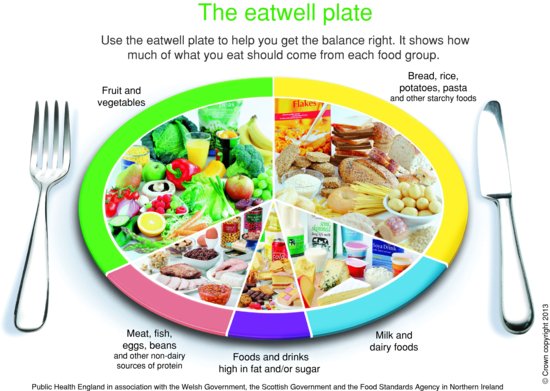Chapter 9
Diet and nutrition
INTRODUCTION
One of the most important roles of the oral health educator (OHE) is to advise patients about diet. In the United Kingdom, the majority of the population is either overweight or obese, and healthy eating advice should be routinely given to patients to promote good general and oral health. Patients will have different dietary demands largely based on their energy needs, yet many people routinely eat more than they need and/or unhealthily.
One of the key messages to be given to patients is to reduce the amount and frequency of foods and drinks with added sugar [1]. (Such is the importance of reducing sugar intake that there is a dedicated chapter on this topic – see Chapter 10.)
The two most important parts of a healthy diet are [1]:
- Eating the right amount of food relative to how active the person is.
- Eating a healthy balanced diet.
A HEALTHY BALANCED DIET (THE EATWELL PLATE)
Diet refers to the type and amount of food and drink we consume. The eatwell plate (Figure 9.1) shows the different types of food we need to eat – and in what proportions – to have a well-balanced and healthy diet [2].
Figure 9.1 The eatwell plate (© Crown copyright 2013. Public Health England in association with the Welsh Government, the Scottish Government and the Food Standards Agency in Northern Ireland)

The eatwell plate (a government policy tool) applies to everyone (except those with special dietary needs who should seek advice from a registered dietician, and children under 2 years old who have different nutritional needs). You should advise patients that they should aim to get this balance right each day, but not necessarily for each meal. For some patients, it may be easier to get the balance right over a week.
Based on the eatwell plate, patients should be advised to eat the following [2]:
- Meals based on starchy foods – bread, cereals, pasta, rice and potatoes (wholegrain varieties are best as they contain more nutrients and give a longer feeling of being full).
- Plenty of fruit and vegetables – at least five portions a day. This can help reduce the risk of heart disease and cancer. They should aim for different varieties (and colours) as different fruit and vegetables contain different combinations of nutrients. One portion is roughly a handful.
- Some milk and dairy foods – great sources of protein and calcium, but aim for mainly low-fat products (to avoid saturated fats).
- Some meat, fish, eggs, beans/pulses – and other non-dairy sources of protein.
- A small amount of foods and drinks high in fat and/or sugar. There are two types of fat – saturated and unsaturated. Patients should be advised to reduce saturated fats, which can increase bad (low-density lipoprotein) cholesterol in the blood and contribute to heart disease, and replace it with unsaturated fat which can lower cholesterol. Saturated fats can be found in foods like butter, cheese, lard, cakes, biscuits, full-fat milk, ghee, chocolate confectionary, pastries and ice cream. Unsaturated fats can be found in foods like vegetable oils, avocados, oily fish (like salmon, tuna and mackerel), nuts and seeds.
- Less salt – which can raise blood pressure. Patients should be wary of processed foods, which provide 75% of the salt we consume [1] and is therefore hidden.
- Drink plenty of water – to keep hydrated.
NUTRITION
Nutrition describes the process by which we absorb and use the food in our />
Stay updated, free dental videos. Join our Telegram channel

VIDEdental - Online dental courses


